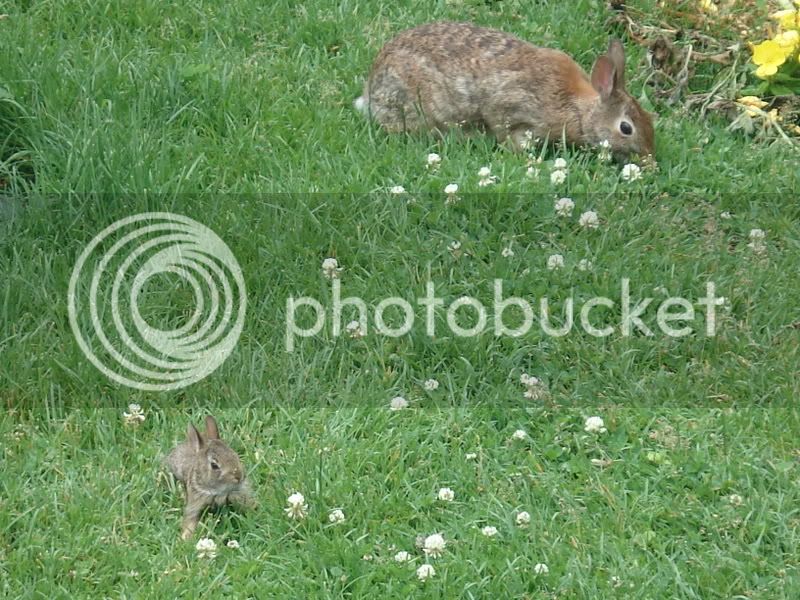Could they bePygmys?Unfortuately many areendangered, almost extinct in WA state, butI think more common in CA.
Sure they're not feraldomestics? Cottontails can be pretty small, too.
http://www.pacificbio.org/ESIN/Mammals/PygmyRabbit/pygmyrabbit_files/image002.jpg
PYGMY RABBIT
1891. Lepus idahoensis Merriam, N. Amer. Fauna, 5:76. Type Locality: Pahsimeroi Valley, near Goldburg, Custer Co., Idaho.
1904. Brachylagus idahoensis, Lyon, Smithsonian Misc. Coll., 45:411.
Distribution: Pygmy[/b] rabbits[/b] are found only in the Great Basin and contiguous areas in Sagebrush-dominated communities. They occur from southeastern Washington southward to about Inyo Co., California[/b], and eastward to western Utah and southeastern Idaho. In California[/b], they occur in eastern Modoc, Lassen, and Mono counties and probably in northern Inyo County. Their occurrence is very spotty throughout their geographic range (Green and Flinders, 1980).
Population Status: Pygmy[/b] Rabbits[/b] have a limited and spotty distribution, being strictly confined to suitable stands of Sagebrush (primarily Artemisia tridentata) and Rabbitbrush (Chrysothamnus spp.). Although Pygmy[/b] Rabbits[/b] may seem common where found, they are not numerous over their geographic range.
The current population status of Pygmy[/b] Rabbits[/b] in California[/b] is unknown, but their numbers have probably declined in the past several years. Loss of habitat to cultivation is less of a factor than loss of habitat by overgrazing. Even though overgrazing favors growth of woody shrubs such as Sagebrush over perennial grasses, cattle often congregate in tall stands of Sagebrush, seeking shade in summer, protection from wind, and relief from insects. Frequently, cattle trample and otherwise open up the understory from ground level up to 1 to 1.5 m, reducing food and shelter for Pygmy[/b] Rabbits[/b]. Brush clearing on rangelands and range fires also reduce available habitat for Pygmy[/b] Rabbits[/b]. In Oregon, Weiss and Verts (1984) found evidence of a marked decrease in occupancy of sites between 1981 and 1983. They suggested that Pygmy[/b] Rabbit populations are susceptible to rapid declines and local extirpations. The fragmentation of Sagebrush communities poses a potential threat to extant populations because of this susceptibility.
Habitat: Pygmy[/b] Rabbits[/b] are associated only with dense stands of tall Sagebrush and rabbitbrush. Soils must be friable for burrowing. Weiss and Verts (1984) found that Pygmy[/b] Rabbits[/b] were associated with areas with greater shrub cover, shrub height, soil strength, and soil depth in comparison to adjacent, unoccupied sites. There was no significant association with percent basal area of perennial grasses, density of annual grasses, density of forbs, or cryptogam cover. Burrows of Pygmy[/b] Rabbits[/b] are usually placed on slopes (Green and Flinders, 1980). Food consists principally of Big Sagebrush (A. tridentata) in winter (up to 99% of the diet), whereas grasses form a significant portion of the diet in summer. White et al. (1982) found differential use of populations of Big Sagebrush, but were unable to associate this with known variations in the chemical composition of A. tridentata populations. Captives, however, showed no significant preference as food for one type of Sagebrush subspecies over others. Weiss and Verts (1984) determined that occupancy of sites by Pygmy[/b] Rabbits[/b] in Oregon was not dependent upon the presence of particular subspecies of Sagebrush.
Recommendations: Detailed information on distribution, habitat associations, abundance, and numbers of Pygmy[/b] Rabbits[/b] killed by hunters in California[/b] are needed. Management of habitat for Pygmy[/b] Rabbits[/b] is probably the most important element in ensuring their survival. Land and resource management agencies in California[/b] should be encouraged to develop needed information on Pygmy[/b] Rabbit populations and to consider habitat for Pygmy[/b] Rabbits[/b] in land and resource management.
Remarks: The Pygmy[/b] Rabbit is designated as a Resident Small Game species in California[/b]. There is an open season for hunting from 1 July through January, with a daily bag limit of five. Although the effect of hunting on Pygmy[/b] Rabbit populations is not known, hunters probably do not kill many because Pygmy[/b] Rabbits[/b] are quite secretive and rarely venture from dense brush; they usually retreat to their burrows when threatened.





